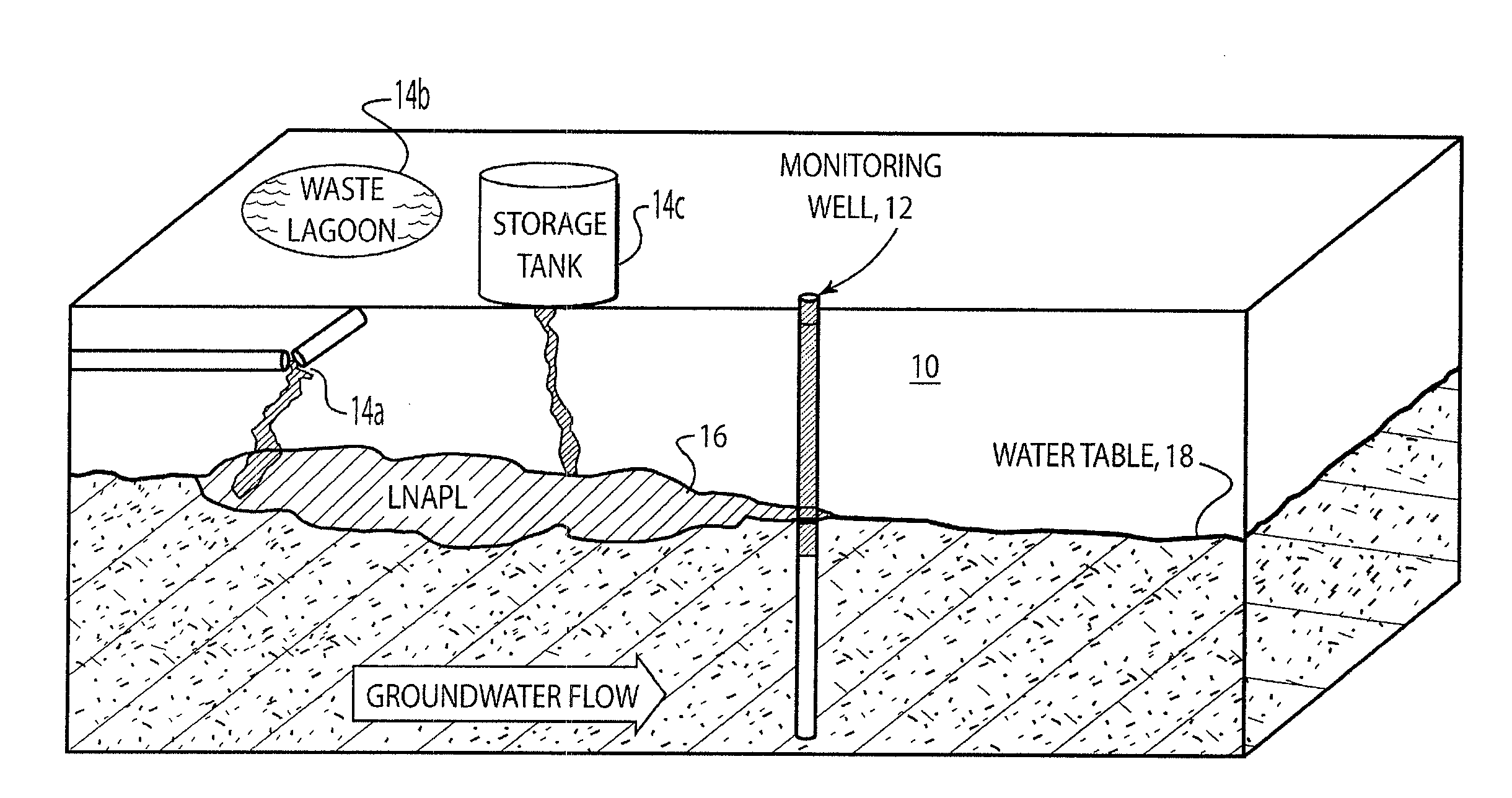Measurement of liquid flow in porous media by tracer dilution without continuous mixing
a tracer dilution and liquid flow technology, applied in the direction of fluid speed measurement, instruments, construction, etc., can solve the problems of increasing resistance to lnapl flow, difficult handling of petroleum liquids, and accumulation of such liquids beneath
- Summary
- Abstract
- Description
- Claims
- Application Information
AI Technical Summary
Benefits of technology
Problems solved by technology
Method used
Image
Examples
example 1
Laboratory Experiments
[0042]Single-well, non-continuous mixing tracer dilution tests were conducted in a sand tank, a schematic representation of a side view thereof being illustrated in FIG. 7, in order to investigate the correspondence between measured LNAPL flow rates using non-continuous mixing tracer dilution with imposed LNAPL flow rates over a range of LNAPL thicknesses and LNAPL flow rates. The sand tank is described in more detail in Taylor, supra, and in Sale et al., supra, and is filled with Unium 4095, a well-sorted, medium-grained, angular quartz sand. Tests were conducted using center well 12 which contains a vertical half-section of a 2-in. inner diameter, 0.030 in. slot, wire wrap stainless steel well screen. The open section of the screen faces the glass in the tank, and a 1-in. filter pack consisting of well-sorted, coarse-grained, angular quartz sand (Unium 2095) was placed around the well screen. Initially, the tank was fully filled with tap water. Subsequently, ...
example 2
Field Experiments
[0049]A first set of measurements involved determining LNAPL fluxes through monitoring wells adjacent to active LNAPL recovery wells to evaluate whether LNAPL fluxes at the wells agreed with LNAPL fluxes at the production wells. A second set of experiments involved measuring LNAPL flow rates in monitoring wells in areas where LNAPL bodies are thought to be largely stable for providing a basis for estimating the minimum LNAPL fluxes that can be measured. Sediments in the intervals where LNAPL is observed consist of fine to medium quartz feldspar sand. The two active recovery wells (R-93, 40, and R-91, 42) employed in the study and associated 2-inch monitoring wells are illustrated in FIGS. 10A and 10B, respectively. The thickness of LNAPL in monitoring wells TW-416, 44, TW-418, 46, TW419, 48, and TW420, 50, were 0.61 ft, 0.65 ft, 0.28 ft, and 0.57 ft, respectively. These wells include 30-slot PVC well screens and coarse gravel packs. Based on monthly data, recovery r...
example 3
Field Experiments Using Water
[0053]The non-continuous mixing tracer dilution method of the present invention was used to measure rates of groundwater flow at five wells completed in an alluvial aquifer. Fluorescein was used as the water soluble tracer at an approximate concentration of 10 mg / L. Due to the small size of the wells (1-inch I.D.), in-well standards could not be placed in each the wells. Alternatively, a single well with no tracer was used as the zero concentration in-well standard. A second well, equipped with a small pipe, closed at the bottom and filled with formation water in which fluorescein was dissolved, was used as the 100% concentration in-well standard. Tracer concentrations were measured 5 times over a period of approximately 24 h. Prior to each measurement, tracer and water in the wells was remixed to achieve a uniform distribution of tracer in the water, in the wells. Changes in tracer concentrations between mixing events were used to estimate groundwater v...
PUM
 Login to View More
Login to View More Abstract
Description
Claims
Application Information
 Login to View More
Login to View More - R&D
- Intellectual Property
- Life Sciences
- Materials
- Tech Scout
- Unparalleled Data Quality
- Higher Quality Content
- 60% Fewer Hallucinations
Browse by: Latest US Patents, China's latest patents, Technical Efficacy Thesaurus, Application Domain, Technology Topic, Popular Technical Reports.
© 2025 PatSnap. All rights reserved.Legal|Privacy policy|Modern Slavery Act Transparency Statement|Sitemap|About US| Contact US: help@patsnap.com



